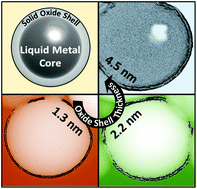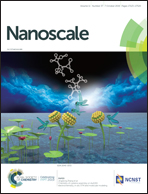Chemically modifying the mechanical properties of core–shell liquid metal nanoparticles†
Abstract
Eutectic gallium–indium (EGaIn) is a room temperature liquid metal that can be readily fabricated into nanoparticles which naturally form a thin, passivating gallium oxide shell. These core–shell nanoparticles are of interest for a variety of stimuli-responsive applications, which often utilize physical deformation of the particles to release the molten, conductive payload from within the gallium oxide shell. In the present work, we introduce a variety of chemical strategies to produce EGaIn nanoparticles which exhibit a wide range of gallium oxide shell thicknesses. These chemically modified oxide thicknesses are then correlated to the core–shell liquid nanoparticles’ mechanical properties by subjecting the particles to orthogonal characterization techniques; XPS for measurement of the gallium oxide shell thickness and nanoindentation for measurement of particle stiffness and elastic modulus. Additionally, nanoindentation is used to determine the onset of particle rupture and resultant conductivity. Ultimately, quantification of the relationships between chemical treatment and derivative mechanical properties in liquid metal nanoparticles will enable advanced applications of these colloids, such as in tailored self-healing and responsive electronic devices.



 Please wait while we load your content...
Please wait while we load your content...